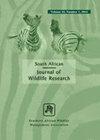Hiding in Plain Sight: Evidence of Hybridization between Cape Mountain Zebra (Equus zebra zebra) and Plains Zebra (Equus quagga burchelli)
引用次数: 6
Abstract
Historically, Cape mountain zebras (Equus zebra zebra) were widely distributed along mountain ranges in the Eastern and Western Cape provinces of South Africa (Boshoff, Landman & Kerley, 2015). By the 1930s, excessive hunting and habitat loss resulted in a reduction in Cape mountain zebra numbers with populations being confined to only five localities. Two of these subpopulations subsequently became extinct. Three relic populations currently exist; the population in the Cradock district,was formally protected in 1937 by the proclamation of the Mountain Zebra National Park (MZNP; Lloyd 1984). The two other populations in the Kammanassie and Gamka Mountains, have been protected since 1923 and 1971, respectively. Cape mountain zebra numbers increased steadily from their critical status of fewer than 80 individuals in the 1950s, to an estimated minimum of 4791 individuals by 2015 (Hrabar & Kerley, 2015). Plains zebra (Equus quagga burchelli) were subsequently introduced, in sympatry with Cape mountain zebra into four formally protected areas, including the MZNP in 1999 and Karoo National Park in 1998. Until recently no cases of hybridization between plains zebra and Cape mountain zebra were known. Hybridization was not of great concern as a threat to Cape mountain zebra populations as fertile hybrids were thought to be unlikely, due to the relatively large difference in the number of chromosomal pairs between the two species (44 versus 32 in plains zebra and Cape mountain zebra, respectively; Ryder, Epel & Benirschke, 1978; Cordingley et al., 2009; Hrabar & Kerley, 2013). By 2013, the plains zebra population had increased substantially in the MZNP (estimated at 769 Cape mountain zebra and 124 plains zebra by aerial census (unpublished aerial census data, 2013) and were potentially competing with Cape mountain zebra for resources. A decision was thus taken to remove the plains zebra. This intervention resulted in a disruption in the social structure, and some of the small, fragmented groups or plains zebra individuals joined Cape mountain zebra herds. In addition, conservation officials observed ‘Cape mountain zebra’ with plains zebra characteristics. These included slight shadow striping, stripes extending all the way down to the ventral midline of the chest and abdomen, and, although they did have the reddish muzzle of mountain zebra, they did not have the characteristic mountain zebra gridiron pattern on their rumps (Fig. 1), but rather had absent or distorted patterns on the rump. They exhibited the distinct dewlap of the Cape mountain zebra and ear shapes were similar to plains zebra. This raised concerns of possible hybridization between the two species. Here, we report on a molecular evaluation using maternal, paternal and biparental markers to identify suspected hybrid Cape mountain and plains zebra in MZNP and Karoo National Park, South Africa.隐藏在平原上:开普山斑马(Equus Zebra)和平原斑马(Equus quagga burchelli)杂交的证据
历史上,开普山斑马(Equus zebra zebra)广泛分布在南非东开普省和西开普省的山脉上(Boshoff, Landman & Kerley, 2015)。到20世纪30年代,过度狩猎和栖息地丧失导致开普山斑马数量减少,种群仅限于五个地方。其中两个亚种群后来灭绝了。现存3个遗迹种群;1937年,山斑马国家公园(MZNP)正式宣布对克拉多克地区的人口进行保护。劳埃德·1984)。另外两个在Kammanassie和Gamka山脉的种群分别从1923年和1971年开始受到保护。开普山斑马的数量从20世纪50年代不到80只的临界状态稳步增长,到2015年估计至少有4791只(Hrabar & Kerley, 2015)。随后,平原斑马(Equus quagga burchelli)与开普山斑马一起被引入四个正式的保护区,包括1999年的南非国家公园和1998年的卡鲁国家公园。直到最近,平原斑马和开普山斑马杂交的案例才为人所知。由于平原斑马和开普山斑马的染色体对数差异较大(分别为44对和32对),杂交被认为不太可能成为开普山斑马种群的威胁,因此不太值得关注;Ryder, Epel & Benirschke, 1978;Cordingley et al., 2009;Hrabar & Kerley, 2013)。到2013年,MZNP的平原斑马种群数量大幅增加(根据2013年未公布的航空普查数据,估计有769头开普山斑马和124头平原斑马),并可能与开普山斑马争夺资源。于是,决定将平原斑马移走。这种干预导致了社会结构的破坏,一些小的、分散的群体或平原斑马个体加入了开普山斑马群。此外,保护官员还观察到“开普山斑马”具有平原斑马的特征。这些条纹包括轻微的阴影条纹,条纹一直延伸到胸部和腹部的腹侧中线,而且,尽管它们确实有山地斑马的红色口吻,但它们的臀部没有山地斑马特有的斑纹(图1),而是臀部没有斑纹或斑纹扭曲。它们表现出开普山斑马独特的耳垂,耳朵形状与平原斑马相似。这引起了人们对两个物种之间可能发生杂交的担忧。本文报道了在南非MZNP和Karoo国家公园使用母本、父本和双亲本标记鉴定可疑的开普山斑马和平原斑马杂交的分子评价。
本文章由计算机程序翻译,如有差异,请以英文原文为准。
求助全文
约1分钟内获得全文
求助全文

 求助内容:
求助内容: 应助结果提醒方式:
应助结果提醒方式:


